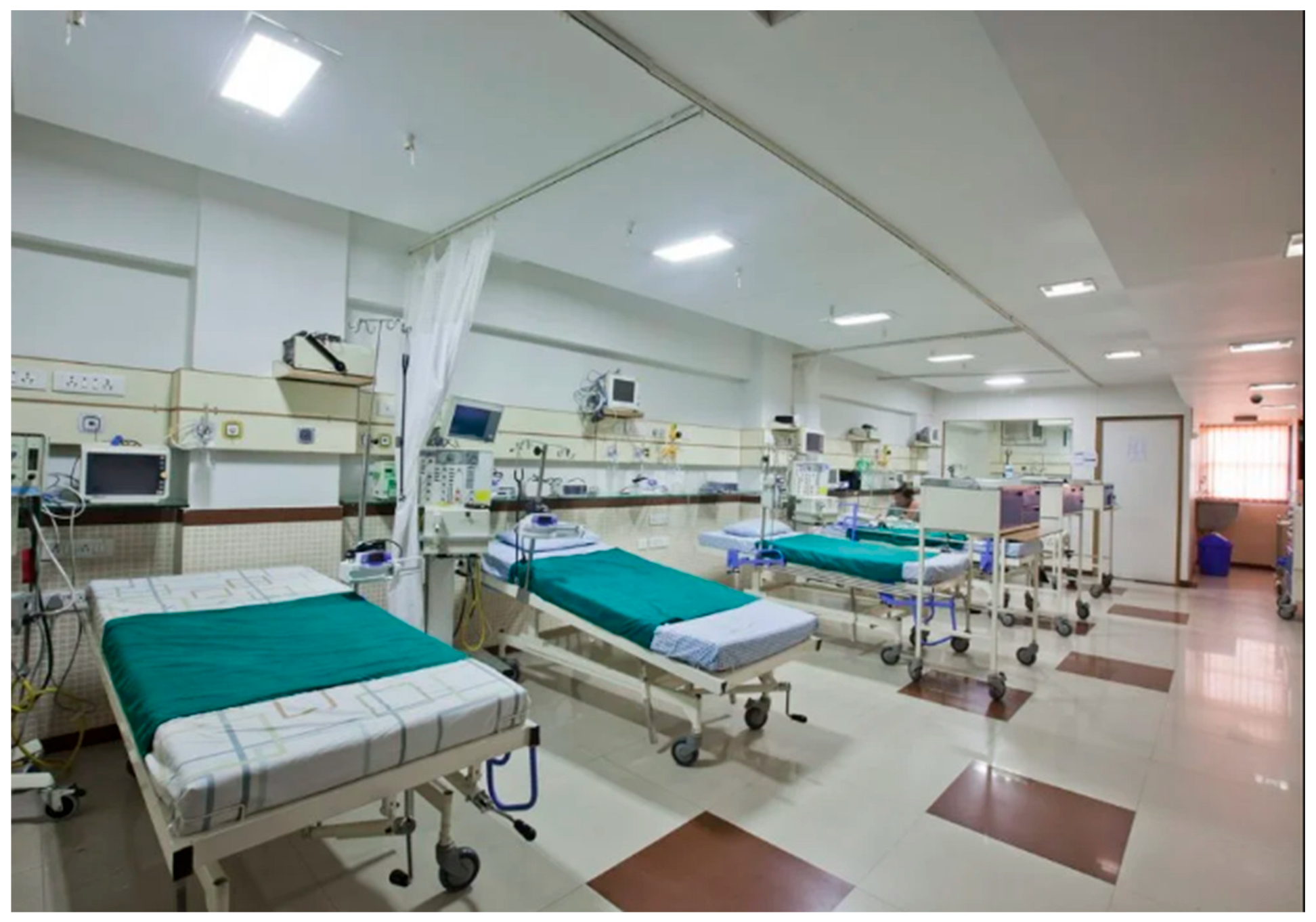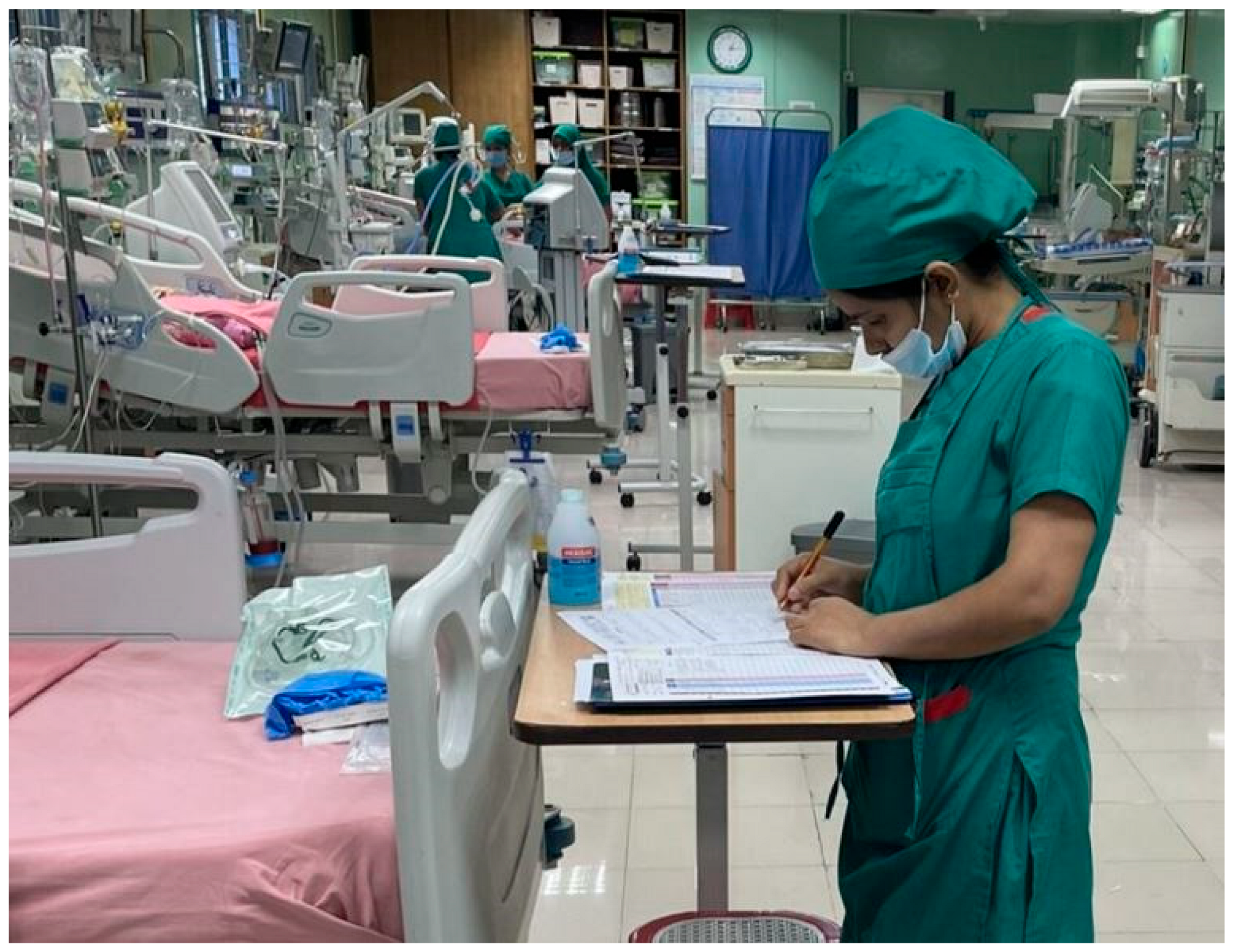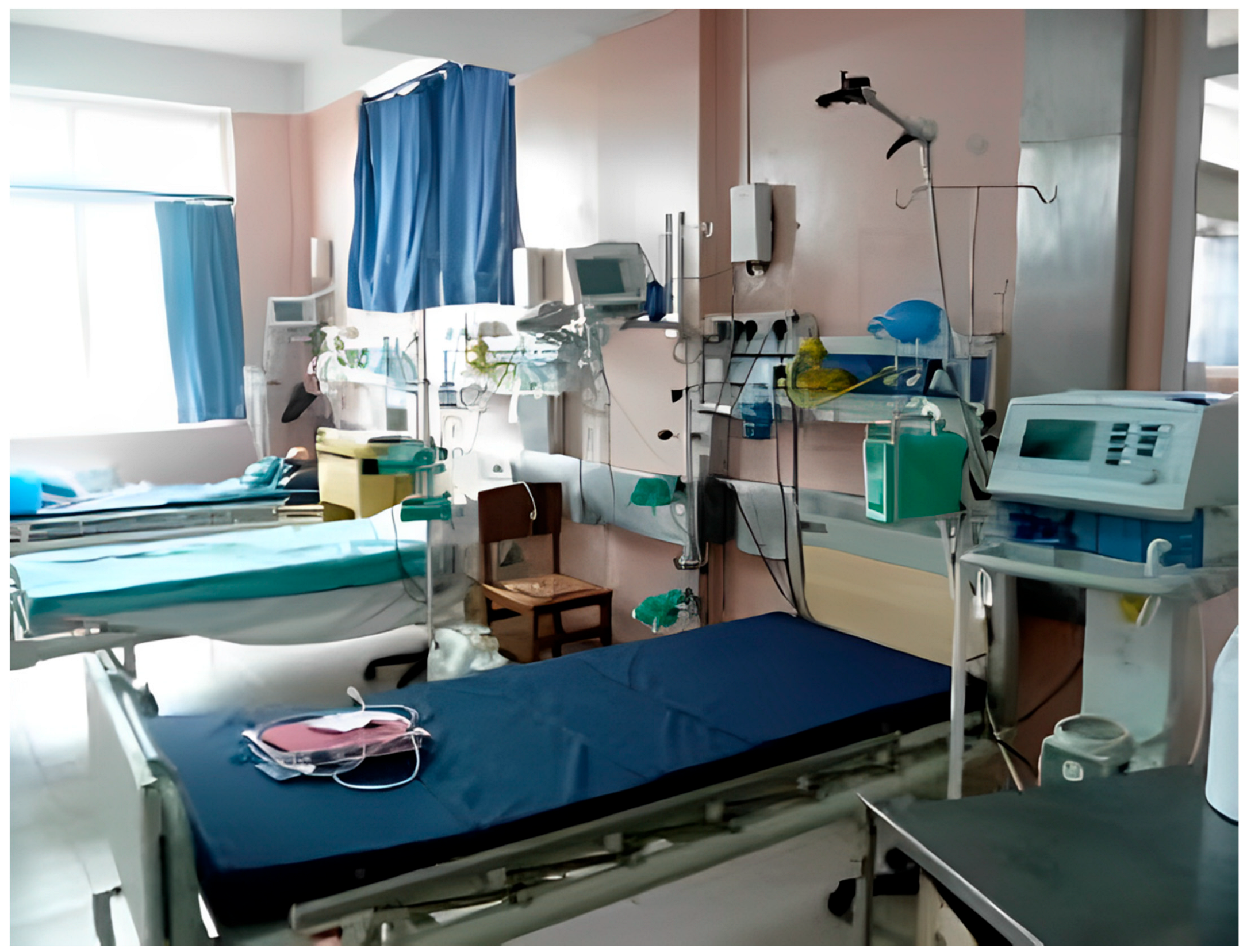Nursing Management in Pediatric Intensive Care in South Asia
Abstract
1. Introduction
2. Methods
3. Overview of Pediatric Intensive Care in South Asia
4. Nursing Management in PICUs: Core Responsibilities
5. Workforce Challenges and Solutions
6. Cultural and Ethical Considerations in Nursing Care
7. Technological and Policy Advancements
8. Implications for Practice and Policy
9. Future Research Directions
10. Discussion
11. Conclusions
Author Contributions
Funding
Institutional Review Board Statement
Informed Consent Statement
Data Availability Statement
Acknowledgments
Conflicts of Interest
References
- Giggles. Importance of Pediatric Intensive Care Units (PICU) in Saving Children’s Life; Giggles: Vizag, India, 2024; Available online: https://giggles.co.in/importance-of-pediatric-intensive-care-units-picu-in-saving-childrens-life/ (accessed on 5 March 2025).
- Slusher, T.M.; Kiragu, A.W.; Day, L.T.; Bjorklund, A.R.; Shirk, A.; Johannsen, C.; Hagen, S.A. Pediatric Critical Care in Resource-Limited Settings—Overview and Lessons Learned. Front. Pediatr. 2018, 6, 49. [Google Scholar] [CrossRef] [PubMed] [PubMed Central]
- Monegro, A.; Muppidi, V.; Regunath, H. Hospital-Acquired Infections; StatPearls Publishing: Treasure Island, FL, USA, 2023. [Google Scholar]
- CDC. Healthcare-Associated Infections (HAIs); CDC: Hong Kong, China, 2024. Available online: https://www.cdc.gov/healthcare-associated-infections/about/index.html (accessed on 5 March 2025).
- Elegant, J.; Sorce, L. Nurse-Driven Care in the Pediatric Intensive Care Unit: A Review of Recent Strategies to Improve Quality and Patient Safety. Curr. Treat. Options Pediatr. 2017, 3, 236–245. [Google Scholar] [CrossRef]
- Rahman, S.A.; Haque, M. Urgency for Pediatric Critical Care Management in Bangladesh. Paediatr. Nephrol. J. Bangladesh. 2021, 6, 1–3. [Google Scholar] [CrossRef]
- Lebet, R.; Vendramim, P.; Pires, M.; Kachmar, A.; Kabara, H.; Pedreira, M.; Curley, M. Pediatric Critical Care Concerns; World Federation of Critical Care Nurses: Sydney, Australia, 2018; Available online: https://wfccn.org/wp-content/uploads/2020/06/Chapter-8_pp64-74_FINAL.pdf (accessed on 5 March 2025).
- González-Dambrauskas, S.; Mislej, C.; Vásquez-Hoyos, P.; Rotta, A. Family Presence and Visitation Practices in Latin American PICUs: An International Survey. J. Pediatr. Intensive Care. 2020, 10, 276–281. [Google Scholar] [CrossRef] [PubMed] [PubMed Central]
- Ramesh, S. Paediatric intensive care—Update. Indian J. Anaesth 2003, 47, 338–344. [Google Scholar]
- Apple Children’s Hospital. Advanced Pediatric Intensive Care Unit (PICU) at a Leading Children Hospital in Ahmedabad; Apple Children’s Hospital: Gujarat, India, 2020; Available online: https://applechildrenhospitals.com/picu-in-ahmedabad (accessed on 6 March 2025).
- Bhalala, U.; Bansal, A.; Chugh, K. Advances in Pediatric Critical Care Research in India. Front. Pediatr. 2018, 6, 150. [Google Scholar] [CrossRef] [PubMed] [PubMed Central]
- Message from president; Criticon Bangladesh 2018. Bangladesh Society of Critical Care Medicine. 2018.
- Mostafa, N. Critical Care Medicine: Bangladesh Perspective. Adv. J. Emerg. Med. 2018, 2, e27. [Google Scholar] [CrossRef] [PubMed] [PubMed Central]
- Hossain, M.; Al Mamun, M.; Hasan, N.; Rima, R.; Jabbar, A. Establishing Pediatric Cardiac Intensive Care Unit in a Low Resource Setting: Bangladesh Perspective and Dhaka Shishu (Children) Hospital Paediatric Cardiac Intensive Care Unit Model. Bangladesh. J. Child. Health. 2017, 39, 3. [Google Scholar] [CrossRef][Green Version]
- Ministry of Health and Family Welfare. National Intensive Care Unit (ICU) Quality Improvement (QI) Framework; Ministry of Health and Family Welfare: New Delhi, India, 2019. Available online: http://qis.gov.bd/wp-content/uploads/2019/05/National-ICU-Quality-Improvement-QI-Framework.pdf (accessed on 7 March 2025).
- Children’s HeartLink. 21 Pictures to Bring You Inside a Children’s Heart Care Training at National Heart Foundation in Bangladesh; Children’s HeartLink: Edina, MI, USA, 2023; Available online: https://childrensheartlink.org/heart-care-training-national-heart-foundation-bangladesh (accessed on 6 March 2025).
- Chaudhary, M.; Rimal, H.; Subedi, R.; Kafle, T. Admission Pattern and Outcome in Paediatric Intensive Care Unit of Tertiary Level Teaching Hospital in Eastern Nepal. Birat. J. Health. Sci. 2023, 8, 1946–1950. [Google Scholar] [CrossRef]
- WFPICCS. PICU in Nepal; WFPICCS: Geneva, Switzerland, 2023; Available online: https://wfpiccs.org/education/sister-picu-program/picu-in-nepal (accessed on 7 March 2025).
- Abbas, Q.; Shahbaz, F.; Hussain, M.; Khan, M.; Shahbaz, H.; Atiq, H.; Bhutta, A. Evaluation of the Resources and Inequities Among Pediatric Critical Care Facilities in Pakistan. Pediatric Critical Care Med. 2023, 24, e611–e620. [Google Scholar] [CrossRef] [PubMed]
- Sloniewsky, D. Critically Ill Children and the ICU Liberation Bundle; SCCM: Mount Prospect, IL, USA, 2023; Available online: https://www.sccm.org/blog/critically-ill-children-and-the-icu-liberation-bundle (accessed on 7 March 2025).
- Al Harbi, S. Early Mobilization in Pediatric Critical Care: Exploring the Gap Between Theory and Practice in Saudi Arabia. Med. Sci. Monit.: Int. Med. J. Exp. Clin. Res. 2024, 30, e942467. [Google Scholar] [CrossRef] [PubMed] [PubMed Central]
- Bassiouny, M.; Elhadidy, A. Continuing professional development system for health-care professions, Egypt. Bull. World Health Organ. 2022, 100, 402–408. [Google Scholar] [CrossRef] [PubMed] [PubMed Central]
- Miller, E.; Yates, P.; Johnstone, S.; Hargraves, M. Co-designing the Palliative Care Hospital experience with clinicians, patients, and families: Reflections from a Co-design Workshop with clinicians. In How Designers are Transforming Healthcare; Springer Nature Link: Singapore, 2024; pp. 207–219. [Google Scholar]
- PNS. PICU Skills Checklist. 2019. Available online: https://professionalnurse.com/picu-skills-checklist (accessed on 8 March 2025).
- Hameed, A.; Shawq, A. Enhancing Pediatric Nursing Skills by Top Learning Strategies. Acad. Open. 2024, 9, 10–21070. [Google Scholar]
- Kaur, A.; Charan, G. A Study to Assess the Knowledge Regarding Medication Error among Staff Nurses at SGRD Hospital, Amritsar, Punjab. Int. J. Health Sci. Res. 2018, 8, 213–216. [Google Scholar]
- Singh, S.; Kodi, S.; Deol, R. 2024. Awareness, Practices, and Contributing Factors toward Medication Errors in Children among Pediatric Nurses. Asian J. Pharm. Res. Health Care. 2024, 16, 37–44. [Google Scholar] [CrossRef]
- Northway, T.; Langley, J.; Skippen, P. Health Care–Associated Infection in the Pediatric Intensive Care Unit. Pediatr. Crit. Care 2011, 1349–1363. [Google Scholar] [CrossRef] [PubMed Central]
- Ngoc, N.; Thuy, D.; Le Chi Thi Kim, N.; Le Nhut, L. Infection Control Practices among Pediatric Critical Care Nurses. SEEJPH 2024, XXV, 2763–2770. [Google Scholar]
- van den Bos-Boon, A.; Hekman, S.; Houmes, R.; Vloet, L.; Gischler, S.; van der Starre, C.; Poley, M. Effectiveness of Simulation Training and Assessment of PICU Nurses’ Resuscitation Skills: A Mixed Methods Study from the Netherlands. Sci. Direct. 2021, 59, e52–e60. [Google Scholar] [CrossRef] [PubMed]
- Flanders, S.; Hampton, D.; Missi, P.; Ipsan, C.; Gruebbel, C. Effectiveness of a Staff Resilience Program in a Pediatric Intensive Care Unit. J. Pediatr. Nurs. 2019, 50, 1–4. [Google Scholar] [CrossRef] [PubMed]
- Herrera, H.; Wood, D. Battling Alarm Fatigue in the Pediatric Intensive Care Unit. Crit. Care Nurs. Clin. 2023, 35, 347–355. [Google Scholar] [CrossRef] [PubMed]
- Larson, C.; Dryden-Palmer, K.; Gibbons, C.; Parshuram, C. Moral Distress in PICU and Neonatal ICU Practitioners: A Cross-Sectional Evaluation*. Pediatr. Crit. Care Med. 2017, 18, e318–e326. [Google Scholar] [CrossRef] [PubMed]
- Molloy, J.; Evans, M.; Coughlin, K. Moral distress in the resuscitation of extremely premature Infants. Nurs. Ethics. 2014, 22, 52–63. [Google Scholar] [CrossRef] [PubMed]
- McCarthy, J.; Gastmans, C. Moral distress: A review of the argument-based nursing ethics literature. Sage J. 2014, 22, 131–152. [Google Scholar] [CrossRef] [PubMed]
- Cheung, W.; Hon, K.; Leung, K.; Hui, W.; Wong, J.; Lee, J.; Ip, P. Moral distress and psychological status among healthcare workers in a newly established paediatric intensive care unit. Hong Kong Med. J. 2023, 29, 489–497. [Google Scholar] [CrossRef] [PubMed]
- Mahon, P. A critical ethnographic look at paediatric intensive care nurses and the determinants of nurses’ job satisfaction. Intensive Crit. Care Nurs. 2014, 30, 45–53. [Google Scholar] [CrossRef] [PubMed]
- Tume, L.; Kneyber, M.; Blackwood, B.; Rose, L. Mechanical Ventilation, Weaning Practices, and Decision Making in European PICUs. Retrieved Pediatr. Crit. Care Med. 2017, 18, e182–e188. [Google Scholar] [CrossRef] [PubMed]
- Wheeler, D.; Dewan, M.; Maxwell, A.; Riley, C.; Stalets, E. Staffing and workforce issues in the pediatric intensive care unit. Transl. Pediatr. 2018, 7, 275–283. [Google Scholar] [CrossRef] [PubMed] [PubMed Central]
- The Guest House. Does Anxiety Lead to Faster Burnout? The Guest House: Hunter Valley, NSW, Australia, 2022; Available online: https://www.theguesthouseocala.com/does-anxiety-lead-to-faster-burnout (accessed on 8 March 2025).
- Lacy, B.; Chan, J. Physician Burnout: The Hidden Health Care Crisis. Clin. Gastroenterol. Hepatol. 2018, 16, 311–317. [Google Scholar] [CrossRef] [PubMed]
- Park, H.; Oh, H.; Boo, S. The Role of Occupational Stress in the Association between Emotional Labor and Mental Health: A Moderated Mediation Model. Sustainability 2019, 11, 1886. [Google Scholar] [CrossRef]
- Rigas, N.; Kyritsis, Z.; Gouroundi, K.; Soldatou, A.; Dagla, M.; Orovou, E.; Antoniou, E. The Mediating Role of Anxiety in the Relationship between Job Satisfaction and Psychosocial Functions of Nurses and Pediatricians in PICUs. Mater. Socio-Medica 2024, 36, 26–32. [Google Scholar] [CrossRef] [PubMed] [PubMed Central]
- Valizadeh, L.; Zamanzadeh, V.; Ghahramanian, A.; Aghajari, P. The Exploration of Culturally Sensitive Nursing Care in Pediatric Setting: A Qualitative Study. Int. J. Pediatr. 2017, 5, 4329–4341. [Google Scholar] [CrossRef]
- Razeq, N.; Arabiat, D.; Ali, R.; Al-Motlaq, M. Nurses’ Beliefs Percept. Regarding Fam.-Centered Care Serv. acute pediatric healthcare settings. J. Pediatr. Nurs. 2024, 75, 16–22. [Google Scholar] [CrossRef] [PubMed]
- WHO. Palliative Care; WHO: Geneva, Switzerland, 2020; Available online: https://www.who.int/news-room/fact-sheets/detail/palliative-care (accessed on 8 March 2025).
- Patel, N.; Shaikh, Z.; Patel, P. Role of AI and Telemedicine in Pediatric Disease Management. Sciforum. 2024. Available online: https://sciforum.net/paper/view/20031 (accessed on 9 March 2025).
- Phua, J.; Faruq, M.; Nafees, K.; Du, B.; Gomersall, C.; Ling, L.; Koh, Y. The story of critical care in Asia: A narrative review. J. Intensive Care. 2021, 9, 60. [Google Scholar] [CrossRef] [PubMed] [PubMed Central]
- Poh, P.; Sng, Q.; Latour, J.; He, L.; Fong, M.; Muralidharah, J.; Lee, J. Pediatric Acute & Critical Care Medicine Asian Network (PACCMAN). Pediatric Critical Care Nursing Research Priorities in Asia: An eDelphi Study. Pediatr. Crit. Care Med. 2022, 23, e498–e506. [Google Scholar] [CrossRef] [PubMed]
- Karageorge, N.; Muckler, V.; Toper, M.; Hueckel, R. Using Simulation With Deliberate Practice to Improve Pediatric ICU Nurses’ Knowledge, Clinical Teamwork, and Confidence. J. Pediatr. Nurs. 2020, 54, 58–62. [Google Scholar] [CrossRef] [PubMed]
- Plant, K. 50 Improving nursing wellbeing in a paediatric intensive care unit (PICU) during the COVID-19 pandemic. Arch. Dis. Child. 2021, 106 (Suppl. S3), 106. [Google Scholar] [CrossRef]
- Collet, J.-P.; Skippen, P.; Mosavianpour, M.; Pitfield, A.; Chakraborty, B.; Hunte, G.; McKellin, W. Engaging Pediatric Intensive Care Unit (PICU) clinical staff to lead practice improvement: The PICU Participatory Action Research Project (PICU-PAR). Implement. Sci. 2014, 9, 6. [Google Scholar] [CrossRef] [PubMed] [PubMed Central]



| Country | First PICU | Current PICU Availability | Key Institutions & Statistics | Challenges |
|---|---|---|---|---|
| India [9,10,11] | 1991 (Chennai, KKCTH) [9] | >100 PICUs (public + private) [11] | 7-bed PICU at KKCT Hospital (first organized unit); led by a pediatric anesthesiologist; teaching institutes crucial [9] | Earlier units lacked support; maintaining a 1:1 nurse-patient ratio remains challenging; training more professionals is crucial |
| Bangladesh [12,13,14,15,16] | 1994 (Dhaka Shishu Hospital) [12] | 11–12 PICUs (public + private) [15] | First ICU in the 1980s at NICVD; 27 government ICUs (22%); 80% of ICUs in Dhaka. [14] | Urban-rural disparity; lack of protocols; private PICUs unaffordable; nurse staffing is inadequate (often ~1:4 nurse: patient) |
| Nepal [17,18] | 1986 (Kanti Children’s Hospital) [17] | 18 independent PICUs [18] | Started with 4 beds; ~2000 annual PICU patients; high critical care burden [18] | Shortage of trained staff; skill gaps in care; staffing often falls short of recommended levels |
| Pakistan [19] | N/A (first survey 2023) [19] | 53 PICUs (of 114 hospitals) [19] | 667 beds, 217 ventilators (nationwide); 38 govt + 15 private PICUs; 16 units with 20 trained intensivists; nurse:patient ~1:3 [19] | Resource shortages; lack of skilled nurses limits infrastructure development |
| Criteria | Assessment | Procedures/Equipment | Access and Line |
|---|---|---|---|
| Cardiovascular | Head-to-Toe | Cardiac Monitor | Care of Central Venous Catheter |
| Heart Sounds | CPR of Infant | Care of Subclavian Lines | |
| Pulses | CPR of Child | Care of Arterial Catheter | |
| Wolf-Parkinson White Syndrome | Preparation of Emergency Drugs | ECMO therapy | |
| Perfusion | Defibrillation | Autotransfusion system | |
| Acyanotic and Cyanotic Heart Disease | Rhythmic recognition | Care of Swanz Ganz Catheter |
| Criteria | Assessment/Equipment/Skills |
|---|---|
| Endocrine Disease | Diabetes/Ketoacidosis |
| Glucose Monitoring Devices | |
| Insulin Drip |
| Criteria | Assessment and Treatment | Procedures and Equipment | Care of Patient on Oxygen Treatment |
|---|---|---|---|
| Respiratory Disease | Asthma | Intubation/Extubation | Mask/Cannula |
| Cystic Fibrosis | Tracheotomy Care | Ambu Bag | |
| Pneumonia | Capillary Blood Gas | Ventilator | |
| Epiglotitis | Arterial Blood Gas | Apnea Monitor | |
| Chest Tubes | Interpretation of Blood Gas | Endo/Naso Tracheal Tube | |
| N/A | O2 Analyzer | ||
| Pulse Oximeter | |||
| Nasal tracheal suctioning | |||
| Endo tracheal suctioning | |||
| Criteria | Experience and Skill |
|---|---|
| Intravenous (IV) Therapy | Peripheral IV Insertion (Angio/Intracath) |
| Administration of Blood/Blood Products | |
| Care of Implanted Vascular Access | |
| Insertion of Scalp Veins | |
| PICC Lines |
| Criteria | Assessment/Equipment/Skills |
|---|---|
| Renal Disease | Foley Catheter Disease |
| Hemodialysis | |
| Renal Transplant | |
| Peritoneal Dialysis |
| Criteria | Assessment/Treatment Disease |
|---|---|
| Hematology/Oncology Disease | Anemia |
| Hemophilia | |
| Administration of Chemotherapy | |
| Immunocompromised patients | |
| Post Bone Marrow Treatments |
| Research Focus Area | Key Questions |
|---|---|
| Workforce Outcome | Impact of nurse-patient ratio on mortality [11,19] |
| Infection Control | Minimizing infection rate by sustainable means [5,29] |
| Wellbeing of Nurses | Longitudinal burnout trajectories [31,39,40] |
| Liberation Bundle Implementation | Effectiveness of Liberation Bundle in LMICs in South Asia [21,23,52] |
| Issue | Scenario in Multiple Countries |
|---|---|
| Limited resources & infrastructure | Disparities exist across South Asia. For instance, India has ~100 fully functional PICUs, whereas Bangladesh struggles with only 11–12 although the exact number of PICUs cannot be stated here concretely due to ethical issues, privacy, and confidentiality of the information originating from the various tiers from governmental to private hospitals. Nepal and Pakistan similarly lack sufficient units and skilled personnel. |
| Nurse–patient ratio & burnout | The ratio is about 1:3 in many Pakistani PICUs, making it difficult for nurses to simultaneously care for multiple critically ill children, leading to burnout and high turnover. Similar staffing shortfalls are seen across the region (e.g., ~1:4 in Bangladeshi PICUs), exacerbating nurse fatigue and compromising patient care. |
| Hospital-acquired infections (HAIs) | PICUs encounter frequent HAIs (e.g., ventilator-associated pneumonia and central line-associated bloodstream infections (CLABSI)). Nurses must rigorously implement infection control to keep infection rates in check given patients’ critical conditions. |
| Lack of evidence-based protocols | Evidence-based protocols like the Liberation Bundle are rarely implemented in South Asian PICUs, reflecting gaps in translating knowledge into practice. |
| Limited family involvement | Parental presence in PICUs is often restricted due to space or policy constraints. By contrast, ~63% of Latin American PICUs permit 24-h parent visitation. Limited family engagement can heighten children’s anxiety, whereas involving parents in care (when feasible) helps reduce stress and improve coping. |
| Patient safety and quality gaps | Many units lack robust patient safety monitoring. Medication errors and ICU infections (VAP, CLABSI) are prevalent concerns, yet safety indicators are not systematically tracked. Inconsistent infection control compliance and limited medication safety training for nurses highlight the need for stronger quality assurance programs. |
Disclaimer/Publisher’s Note: The statements, opinions and data contained in all publications are solely those of the individual author(s) and contributor(s) and not of MDPI and/or the editor(s). MDPI and/or the editor(s) disclaim responsibility for any injury to people or property resulting from any ideas, methods, instructions or products referred to in the content. |
© 2025 by the authors. Licensee MDPI, Basel, Switzerland. This article is an open access article distributed under the terms and conditions of the Creative Commons Attribution (CC BY) license (https://creativecommons.org/licenses/by/4.0/).
Share and Cite
Hirao, D.; Jesmin, S.; Sugasawa, T.; Maqbool, A.; Shimojo, N. Nursing Management in Pediatric Intensive Care in South Asia. Children 2025, 12, 726. https://doi.org/10.3390/children12060726
Hirao D, Jesmin S, Sugasawa T, Maqbool A, Shimojo N. Nursing Management in Pediatric Intensive Care in South Asia. Children. 2025; 12(6):726. https://doi.org/10.3390/children12060726
Chicago/Turabian StyleHirao, Daigo, Subrina Jesmin, Takehito Sugasawa, Adil Maqbool, and Nobutake Shimojo. 2025. "Nursing Management in Pediatric Intensive Care in South Asia" Children 12, no. 6: 726. https://doi.org/10.3390/children12060726
APA StyleHirao, D., Jesmin, S., Sugasawa, T., Maqbool, A., & Shimojo, N. (2025). Nursing Management in Pediatric Intensive Care in South Asia. Children, 12(6), 726. https://doi.org/10.3390/children12060726





